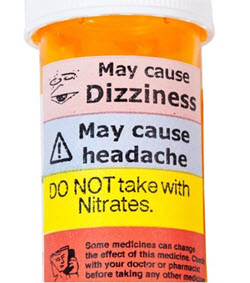Last week, one of the employees at the condo building where I reside posed this question to me: “Joe, I’ve been prescribed the antidepressant Cymbalta. I’ve been taking it before I go to bed for 2 weeks now and I’m having a lot of difficulty getting to sleep.”
 I asked her if she happened to have the prescription bottle with her. She did, and when I looked at the directions, they stated — Take one capsule daily. I mentioned that feeling “activated” is a side effect of Cymbalta, and that she should consider taking it in the morning instead. She did just that, and one week later, reported she was sleeping much better. I inquired as to whether the possible side effects of Cymbalta were discussed when she first received the prescription and she replied, “He rattled off some side effects as he was writing the prescription, so I might have missed it.”
I asked her if she happened to have the prescription bottle with her. She did, and when I looked at the directions, they stated — Take one capsule daily. I mentioned that feeling “activated” is a side effect of Cymbalta, and that she should consider taking it in the morning instead. She did just that, and one week later, reported she was sleeping much better. I inquired as to whether the possible side effects of Cymbalta were discussed when she first received the prescription and she replied, “He rattled off some side effects as he was writing the prescription, so I might have missed it.”
Drug side effects occur, because once the active ingredient of the medication is absorbed and distributed throughout the body, targets — known as receptors — are sought out. The actions of drugs at receptor sites then unleash the intended effect or generate unwanted and often undesirable adverse effects. Most side effects tend to be on the mild side and are time-limited, disappearing within a week or two after starting the drug. Side effects of some psychotropics do persist throughout the course of administration, with sexual dysfunction and weight gain most prevalent.
Whether it is a new medication that has been prescribed for a client of mine or one the client is already taking, I provide them a physical list of the common, most often reported side effects of that particular drug. I keep the list short — no more than 5 possible adverse effects — and include what percentage of patients experience each one of them. No client needs to hear a litany of 10-20 possible side effects because this is too complicated and difficult to remember. All they need to know about at first are the frequently occurring ones. If others not included on the list I provide emerge, I’ll deal with that at the next session with the client or between sessions via telephone or e-mail.
 As for potentially serious side effects, don’t withhold information regarding these either, if asked about them. Some clinicians do so out of fear that they will scare a client away from a medication that may be very helpful for them, but the truth is a simple Google search will yield information about any prescription drug on the planet. Serious side effects shouldn’t be on the short list of the 5 alluded to above, but if you’re asked, recognize that clients are entitled to weigh the benefits and risks associated with making an informed decision. It’s their choice in the end, as it would be ours if we were in a similar position.
As for potentially serious side effects, don’t withhold information regarding these either, if asked about them. Some clinicians do so out of fear that they will scare a client away from a medication that may be very helpful for them, but the truth is a simple Google search will yield information about any prescription drug on the planet. Serious side effects shouldn’t be on the short list of the 5 alluded to above, but if you’re asked, recognize that clients are entitled to weigh the benefits and risks associated with making an informed decision. It’s their choice in the end, as it would be ours if we were in a similar position.
An example: Let’s say a client of yours has been diagnosed with bipolar disorder, started on the drug Lamictal (lamotrigine) — which is linked to a possibly very serious rash — and the client is quite fearful of this. Start by telling the person that very serious side effects are extremely rare. Follow up with an actual fact: 1 in 1000 people taking Lamictal for bipolar disorder develops this serious rash, which means that 999 out of 1000 do not. Then inform them that to reduce the chances of rash development even further, dosing can begin very low and titrated up very slowly as warranted.
After a client has been started on a medication, and if you haven’t heard from them between sessions, it’s good practice to ascertain how they’re doing on the drug. Ask about therapeutic benefits for sure, but also inquire about side effects. Ask: “Have you experienced any side effects since beginning the drug?” If they mention a symptom or two, follow up with “any others?” This will jog their memory a bit, providing you an opportunity to discuss the full range of what’s happening and craft remedies accordingly.
Side effects are the number one reason people abort psychotropic medication. And in my many years of experience, some of them stop the drug(s) when the side effects are right on the cusp of diminishing or disappearing. In most instances, basic interventions such as taking the medication in the morning rather than at bedtime, and taking it with food or on an empty stomach will suffice to help the client feel better. When this doesn’t work, other drugs may need to be prescribed to attack the adverse effect directly.
And then there’s a little cheerleading on our part to keep the client focused on the benefits of the medication, if they’ll just stay with it — in spite of some more than likely, temporary discomfort.
Attribution Statement:
Joe Wegmann is a licensed pharmacist & clinical social worker has presented psychopharmacology seminars to over 10,000 healthcare professionals in 46 states, and maintains an active psychotherapy practice specializing in the treatment of depression and anxiety. He is the author of Psychopharmacology: Straight Talk on Mental Health Medications, published by PESI, Inc.
To learn more about Joe’s programs, visit the Programs section of this website or contribute a question for Joe to answer in a future article: joe@thepharmatherapist.com.